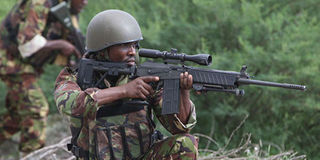Kenya military expenditure rises to Sh121.82 billion

Kenya Defence Forces soldiers take their positions during an operation against Shabaab militants in Afmadow town, Somalia, on November 22, 2015. PHOTO | FILE | NATION MEDIA GROUP
What you need to know:
Last month a similar report by Sipri, which tracked actual arms delivery showed that Kenya had spent Sh3.78 billion in payments for the arms it received in 2019.
Nairobi also recorded a rise in its ranking on the amount spent in military arms to position 62 last year, from 95 the previous year, showing its rise in arms import spending appetite.
Kenya’s military expenditure rose to Sh121.82 billion last year, up from Sh116.19 billion in 2018 as the country sought to modernise its hardware.
According to the Stockholm International Peace Research Institute (Sipri) 2019 Military Expenditure Database report released Monday, Nairobi saw the over Sh5.7 billion, mostly driven by the its rising appetite for arms imports.
The spending is in line with the allocation of National Treasury for the Kenya Defense Forces (KDF), which had set aside Sh23.7 billion in the current 2019/2020 financial year on weapons acquisition, a rise from the 2018/19 spending of Sh109 billion to Sh121 billion.
“Of the Sh121 billion spending proposed for the KDF, Sh23.7 billion will go into buying military hardware in a ‘defense modernisation’ drive,” the National Treasury said. This allocation was a sharp increase from the Sh17.5 billion spent on the same in 2018/2019.
Last month a similar report by Sipri, which tracked actual arms delivery showed that Kenya had spent Sh3.78 billion in payments for the arms it received in 2019. Nairobi also recorded a rise in its ranking on the amount spent on military arms to position 62 last year, from 95 the previous year, showing its rise in arms import spending appetite.
Kenya, however, does not make public its military purchases, and only Parliament is mandated to scrutinise the classified expenditure by security agencies.
Some of Kenya’s arms expenditure items have been revealed through other international sources, which illustrate the race to strengthen the country’s military might. Kenya has traditionally preferred to purchase its arms and weapons from Serbia, Russia, China and Israel, with some of these purchases now coming in from Italy and the United States.
According to the data by Sipri, an independent global security think tank, Kenya in 2019, received from Italy the last batch of the three C-27J Spartan Transport aircraft ordered in 2017. It also received two of the AW139 Helicopter ordered in 2018. This delivery, Sipri said, included one helicopter “for VIP transport” from Poland.
From the United States, the Kenyan military received two of the M28 Skytruck planes, which was part of military aid, with the planned delivery of the last one set for later this year. KDF in 2019 also received six of the Rolls-Royce AE-2100 engines for the C-27J Spartan Transport aircrafts it had ordered from Italy’s firm Leonardo at a cost of Sh20 billion. They are expected to replace the ageing fleet of De Havilland Canada DHC-5 Buffalos.
Washington also delivered to Nairobi six of armed MD 530F Cayuse Warrior helicopters that were ordered in 2018. The deal also included initial logistics support (ILS) for the aircraft, aircraft systems and ground support equipment.
In 2018, Kenya topped in its military spending in the region forking Sh109.7 billion to stand above those of neighbours Tanzania and Uganda combined.
Nairobi spending on its military in 2018 by Sh8.2 billion from Sh101.5 billion in 2017, pushed its defence bill to become the sixth largest in Africa. Tanzania’s military spending in 2018 rose to Sh67.5 billion, while Uganda came in third in the region at Sh40.8 billion.
The five largest spenders in 2019, which accounted for 62 per cent of expenditure, were the United States, China, India, Russia and Saudi Arabia. This is the first time that two Asian states have featured among the top three military spenders.
The latest Sipri arms expenditure data shows that United States still drives global growth in military spending, splashing Sh77.6 trillion in 2019, which accounted for 38 per cent of global military spending.
‘The recent growth in US military spending is largely based on a perceived return to competition between the great powers,’ says Pieter D Wezeman, Senior Researcher at Sipri.
China and India top Asian military spending, becoming the second- and third-largest military spenders in the world. China’s military expenditure reached $27.69 trillion in 2019, while India’s grew by 6.8 per cent to $71.1 billion.
Within Africa, the combined military expenditure of states grew by 1.5 per cent to an estimated Sh4.37 trillion in 2019—the region’s first spending increase for five years.





